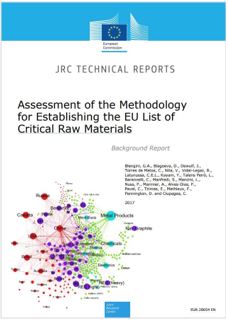Decreto 21 dicembre 1995
Disciplina dei metodi di controllo delle emissioni in atmosfera dagli impianti industriali.
(GU Serie Generale n.5 del 08.01.1996)
Provvedimento abrogato dall'art. 2...

This report presents the results of work carried out by the Directorate General (DG) Joint Research Centre (JRC) of the European Commission (EC), in close cooperation with Directorate-General for Internal Market, Industry, Entrepreneurship and SMEs (GROW), in the context of the revision of the EC methodology that was used to identify the list of critical raw materials (CRMs) for the EU in 2011 and 2014 (EC 2011, 2014).
As a background report, it complements the corresponding Guidelines Document, which contains the “ready-to-apply” methodology for updating the list of CRMs in 2017. This background report highlights the needs for updating the EC criticality methodology, the analysis and the proposals for improvement with related examples, discussion and justifications. However, a few initial remarks are necessary to clarify the context, the objectives of the revision and the approach.
As the in-house scientific service of the EC, DG JRC was asked to provide scientific advice to DG GROW in order to assess the current methodology, identify aspects that have to be adapted to better address the needs and expectations of the list of CRMs and ultimately propose an improved and integrated methodology. This work was conducted closely in consultation with the adhoc working group on CRMs, who participated in regular discussions and provided informed expert feedback. The analysis and subsequent revision started from the assumption that the methodology used for the 2011 and 2014 CRMs lists proved to be reliable and robust and, therefore, the JRC mandate was focused on fine-tuning and/or targeted incremental methodological improvements. An in depth re-discussion of fundamentals of criticality assessment and/or major changes to the EC methodology were not within the scope of this work.
High priority was given to ensure good comparability with the criticality exercises of 2011 and 2014. The existing methodology was therefore retained, except for specific aspects for which there were policy and/or stakeholder needs on the one hand, or strong scientific reasons for refinement of the methodology on the other. This was partially facilitated through intensive dialogue with DG GROW, the CRM adhoc working group, other key EU and extra-EU stakeholders.
The following considerations summarise the framework and scope of the analyses presented in this report and the subsequent revision of the methodology summarised in the Guidelines:
- Ensure the highest possible level of comparability with the 2011 and 2014 lists
- Intense and active dialogue with stakeholders since an early-stage in the revision
- Non-forward looking approach in the assessment, i.e. criticality is seen as a “snapshot in time” of the current (or past) raw materials situation
- Use of best quality data reflecting the average of data for the last 5 years.
European Commission 2017
Correlati:
Methodology for establishing the EU list of critical raw materials
Disciplina dei metodi di controllo delle emissioni in atmosfera dagli impianti industriali.
(GU Serie Generale n.5 del 08.01.1996)
Provvedimento abrogato dall'art. 2...

ID 24704 | 09.10.2025 / In allegato Comunicato Stampa CdM
Il Consiglio dei Ministri, nella seduta n. 144 del...
Misure urgenti per la prevenzione dell'inquinamento atmosferico da benzene.
(GU n. 282 del 3 dicembre 1997)
Articolo 4 della legge 4 novembre 1997 n. 413 abrogat...
Testata editoriale iscritta al n. 22/2024 del registro periodici della cancelleria del Tribunale di Perugia in data 19.11.2024